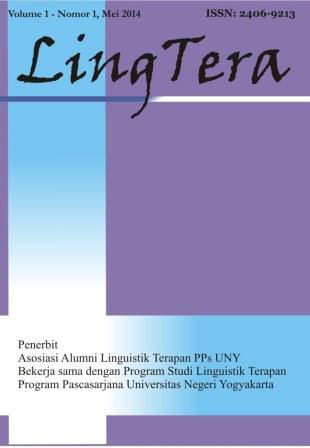Struktur wacana berita pendidikan dalam surat kabar Kompas
DOI:
https://doi.org/10.21831/lt.v8i1.14905Keywords:
discourse structure, the educational news, struktur wacana, berita pendidikanAbstract
Penelitian ini bertujuan untuk mendeskripsikan dan menjelaskan struktur tematik, skematik, semantik, sintaksis, dan stilistik berita pendidikan dalam surat kabar Kompas. Penelitian ini merupakan penelitian deskripsi kualitatif. Hasil penelitian ini adalah sebagai berikut. Pertama, tematik yang dikedepankan yaitu Kurikulum 2013 yang didukung topik dan tema. Kedua, skematik berita pendidikan disusun dengan skema summary yang mencakup judul dan lead, dan story yang berupa komentar narasumber serta kesimpulan wartawan berdasarkan pernyataan narasumber. Ketiga, semantik mencakup latar, detil, maksud, dan praanggapan. Elemen tersebut mengungkapkan makna yang ditekankan pada hal-hal atau peristiwa yang terjadi pada pelaksanaan Kurikulum 2013 selama tahun pelajaran 2014/2015. Keempat, sintaksis mencakup bentuk kalimat, kohesi, koherensi, dan kata ganti. Pada bentuk kalimat, Kompas menggunakan kalimat aktif dikarenakan untuk menonjolkan narasumber. Kohesi dan koherensi menunjukkan bahwa berita pendidikan sebagai wacana yang utuh, padu dan runtut. Kelima, stilistik berkaitan dengan pilihan kata (leksikon). Pilihan kata yang digunakan Kompas cenderung halus, sopan, dan universal. Hal tersebut menunjukkan kesan positif terhadap narasumber dan Kurikulum 2013.
The discource structure of educational news in Kompas newspaper
Abstract
This study is aimed at: describing and explaining thematic, schematic, semantic, syntactic, and stylistic structures of education news in Kompas newspaper. This research was a qualitative research. The study reveals five findings as follows. First, the main thematic is Curriculum 2013 which is supported by topics and themes. Second, the schematic of educational news is arranged by a summary scheme which includes titles and leads while the story scheme is the commentary of interviewees and journalist's conclusion from the interviewees' statement. Thirdly, semantics includes background, detail, intent, and presupposition. The element expresses the emphasis on the things or events that occured in the implementation of Curriculum 2013 during the academic year 2014/2015. Fourth, syntax includes sentence form, cohesion, coherence, and pronoun. In the form of a sentence, Kompas uses active sentences because of accentuate the interviewees. Cohesion and coherence show that the educational news is as integrated discourse, united and coherent. Fifth, stylistic is related to the word choice (lexicon). Kompas uses universal, smooth and polite choice of words. It shows a positive impression to the interviewees and Curriculum 2013.
References
Arifin, B. & Rani, A. (2000). Prinsip-prinsip analisis wacana. Jakarta, Direktorat Jenderal Pendidikan Tinggi.
Chaer, A. (2006). Tata bahasa praktis bahasa indonesia (Edisi revisi). Jakarta: Rineka Cipta
Cummings, L. (2009). Clinical pragmatics. Cambridge: Cambridge University Press.
Dascalu, M., Trausa-Matu, S., Dessus, P., McNamara, D. S. (2015). Dicsourse cohesion: a signature of collaboration. Proceedings of the Fifth International Conference on Learning Analytics & Knowledge, USA, 350-354.
Eriyanto. (2001). Analisis wacana: pengantar analisis teks media. Yogyakarta: LKiS.
Gutwinski, W. (1976). Cohesion in literary texts: a study of some grammatical and lexical features of English discourse. The Hague: Mouton.
Halliday, M. A. K., & Hasan, R. (1992). Bahasa, konteks, dan teks: aspek-aspek bahasa dalam pandangan semiotik sosial (terjemahan Asruddin Barori Tou). Yogyakarta: Gadjah Mada University Press.
Halwati, U. (2011). Analisis Teun A. van Dijk dalam kajian wacana teks dakwah di media massa. Komunika, 5, 1-10.
Ishwara, L. (2011). Jurnalisme dasar. Jakarta: Kompas.
Lin, Z. (2011). Discourse paising: inferring discourse structure, modeling coherence, and its application. Thesis. National University of Singapura.
Mallarangeng, R. (2010). Pers orde baru: tinjauan isi kompas dan suara rakyat. Jakarta: Kepustakaan Populer Gramedia
Michael, A. S., Muthusamy, C., Suppiah, P. C., Joseph, C., Masturina, S. (2013). Cohesion in news articles: a discourse analysis approach. International Journal of Applied Linguistics & English Literature, 2, 129-133.
Renkema, J. (2004). Introduction to discourse studies. Philadelphia: John Benjamins Publishing Company.
Sen, K., & Hill, D. T. (2007). Media, culture, and politics in indonesia. Jakarta: Equinox Publishing Indonesia.
Utama, I. D. G. B. (2015). Analisis wacana kritis berita tentang rancangan tata ruang wilayah provinsi (rtrwp) bali dalam harian bali post. Tesis. Denpasar: Universitas Udayana.
Van Dijk, T. A (ed). (1985). Structure of news in the press : discourse and communication. Berlin: De Guyter.
Van Dijk, T. A. (1988). News as discourse. United States of Amerika: Lawrence Erlbaum Associates.
Van Dijk, T. A (ed). (1997). Discourse as structure and process: discourse studies a multidiciplinary introduction volume i. London: Sage.
Yazgan, P., & Utku, D. E. (2016). News discourse and ideology: critical analysis of copenhagen gang wars online news. Migration Letters, 14, 145-160.
Yule, G. (1996). Pragmatics. Oxford: Oxford University Press.
Zare', J., Abbaspour, E., Nia, M. R. (2012). Presupposition trigger: a comparative analysis of broadcast news discourse. International Journal of Linguistics, 4, 734-743.
Downloads
Published
How to Cite
Issue
Section
Citation Check
License
LingTera allows readers to read, download, copy, distribute, print, search, or link to its articles' full texts and allows readers to use them for any other lawful purpose. The journal allows the author(s) to hold the copyright without restrictions. Finally, the journal allows the author(s) to retain publishing rights without restrictions.
- Authors are allowed to archive their submitted articles in an open-access repository.
- Authors are allowed to archive the final published article in an open-access repository with an acknowledgment of its initial publication in this journal.

Psychology, Evaluation, and Technology in Educational Research is licensed under a Creative Commons Attribution-ShareAlike 4.0 International License.
Based on a work at https://petier.org/index.php/PETIER.









